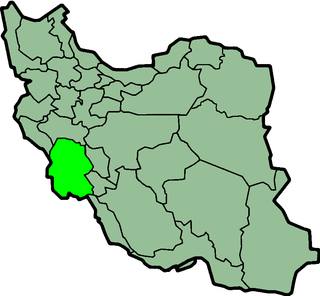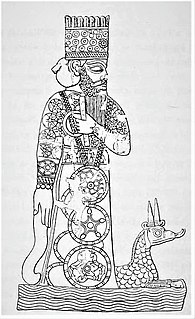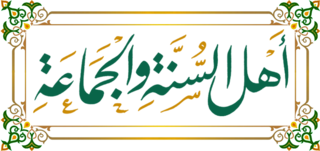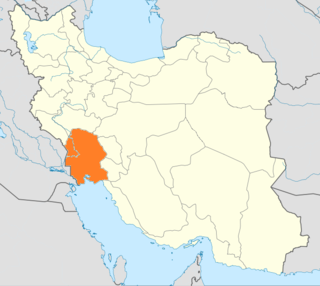Sectarianism is a political or cultural conflict between two groups which are often related to the form of government which they live under. Prejudice, discrimination, or hatred can arise in these conflicts, depending on the political status quo and if one group holds more power within the government. Often, not all members of these groups are engaged in the conflict. But as tensions rise, political solutions require the participation of more people from either side within the country or polity where the conflict is happening. Common examples of these divisions are denominations of a religion, ethnic identity, class, or region for citizens of a state and factions of a political movement.

Khuzestan Province is one of the 31 provinces of Iran. It is in the southwest of the country, bordering Iraq and the Persian Gulf. Its capital is Ahvaz and it covers an area of 63,238 square kilometres (24,416 sq mi). Since 2014, it has been part of Iran's Region 4.

Ahvaz is a city in the southwest of Iran and the capital of Khuzestan province. Ahvaz's population is about 1,300,000 and its built-up area with the nearby town of Sheybani is home to 1,136,989 inhabitants. It is home to Persians, Arabs, Bakhtiaris, Dezfulis, Shushtaris, and others. Languages spoken in the area include Persian and Arabic, as well as dialects of Luri (Bakhtiari), Dezfuli, Shushtari, and others.
This article focuses on the status of ethnic minorities in contemporary Iran.

Khuzestan Province is a petroleum-rich, ethnically-diverse province in southwestern Iran. Oil fields in the province include Ahvaz Field, Marun, Aghajari, Karanj, Shadegan and Mansouri. Amnesty International has voiced human-rights concerns about Khuzestan's Arab population, and United Nations special rapporteur Miloon Kothari has also drawn attention to Arab displacement and poverty among the Laks.

Iranian Arabs refers to Iranian citizens who speak Arabic as their native language. In 2008, Iranian Arabs comprised about 1.6 million people, and are primarily located in Khuzestan Province.

The history of Khuzestan Province, a province in southwestern Iran, extends from the ancient pre-Aryan Elamite civilization to the modern day Islamic Republic.
The Ahvaz bombings were a series of bomb explosions, that took place mostly in Ahvaz, Iran in 2005 and 2006, and were blamed on Ahvaz separatist organizations of Arabs. The bombings were linked to the violent '15 April unrest' in Ahvaz, prior to the bombings. Some 28 people were killed and 225 wounded in Ahvaz bombings.

Religion in Iraq dates back to Ancient Mesopotamia, particularly Sumer, Akkad, Assyria and Babylonia between circa 3500 BC and 400 AD, after which they largely gave way to Syriac Christianity and later to Islam.

The Arab Struggle Movement for the Liberation of Ahwaz is an Arab nationalist and separatist insurgent group which advocates the secession of Khuzestan Province from Iran and the establishment of an Arab state, a goal which it is attempting to achieve by waging a direct and violent conflict against Iran.

The origin of Shia–Sunni relations can be traced back to a dispute over the succession to the Islamic prophet Muhammad as a caliph of the Islamic community. After the death of Muhammad in 632, a group of Muslims, who would come to be known as the Sunnis, believed that Muhammad's successor should be Abu Bakr, whereas a second group of Muslims, who would come to be known as the Shias, believed that his successor should have been Ali. This dispute spread across various parts of the Muslim world, which eventually led to the Battle of Jamal and Battle of Siffin. Sectarianism based on this historic dispute intensified greatly after the Battle of Karbala, in which Husayn ibn Ali and some of his close partisans, including members of his household, were killed by the ruling Umayyad Caliph Yazid I, and the outcry for revenge divided the early Islamic community, albeit disproportionately, into two groups, the Sunni and the Shia. This is known today as the Islamic schism.
The majority of the population of Iran consists of Iranic peoples. The largest groups in this category include Persians and Kurds, with smaller communities including Gilakis, Mazandaranis, Lurs, Tats, Talysh, and Baloch.
The Safavid conversion of Iran to Shia Islam was a process of forced conversion that took place roughly over the 16th through 18th centuries and turned Iran (Persia), which previously had a Sunni majority population, into the spiritual bastion of Shia Islam. It was a process that resulted in hostility with Iran's Sunni neighbours, mostly the Ottoman Empire. The conversion also ensured the dominance of the Twelver sect within Shiism over the sects of Zaidiyyah and Isma'ilism – each of whom had previously experienced their own eras of dominance within Shiism. Through their actions, the Safavids reunified Iran as an independent state in 1501 and established Twelver Shiism as the official religion of their empire, marking one of the most important turning points in the history of Islam.

2005 Ahvaz unrest or 15 April Ahvaz Protests were violent riots, initiated by Iranian Arabs in the city of Ahvaz in southwestern Iranian province of Khuzestan. The unrest erupted on 15 April 2005, and lasted for 4 days. Initially, the Iranian Interior Ministry stated that only one person had been killed, however an official at a hospital in Ahvaz said that there were between 15 and 20 mortal casualties. Government officials blamed the unrest on Britain, whose troops based just across the border in southern Iraq. Following the unrest, several bombings were carried out in Ahvaz, killing 28 people. In 2006, Iran executed five Arab separatists, convicted of carrying out the bombings in 2005.
The 2011 Khuzestan protests, known among protesters as the Ahvaz Day of Rage, relates to violent protests, which erupted on 15 April 2011 in Khuzestan Province, to mark an anniversary of the 2005 Ahvaz unrest, and as a response to the regional Arab Spring. The protests lasted for 4 days and resulted in 12 to 15 protesters killed and many wounded and arrested. 1 security officer was killed as well, and another wounded. Crackdown on Arab political opposition in the area continued since with arrests and executions.

Arab separatism in Khuzestan refers to the century-long separatist Arab movement in the western part of the Khuzestan Province in Iran.
Islamic Reconciliation Party or Al-Wefaq Islamic Party formerly named Reconciliation Committee, was an Iranian local ethnic party associated with Arab minority in Khuzestan Province.
The 2018 Khuzestan protests, that are dubbed “the Uprising of Dignity”, were a series of protests by Iranian Arabs located in the Khuzestan province of Iran. The protests started on 28 March 2018, and were against discrimination towards the ethnic Arab minority.
Shariatism is a body of ideas that describes the inspiration, vision, and the life work of Ali Shariati.










